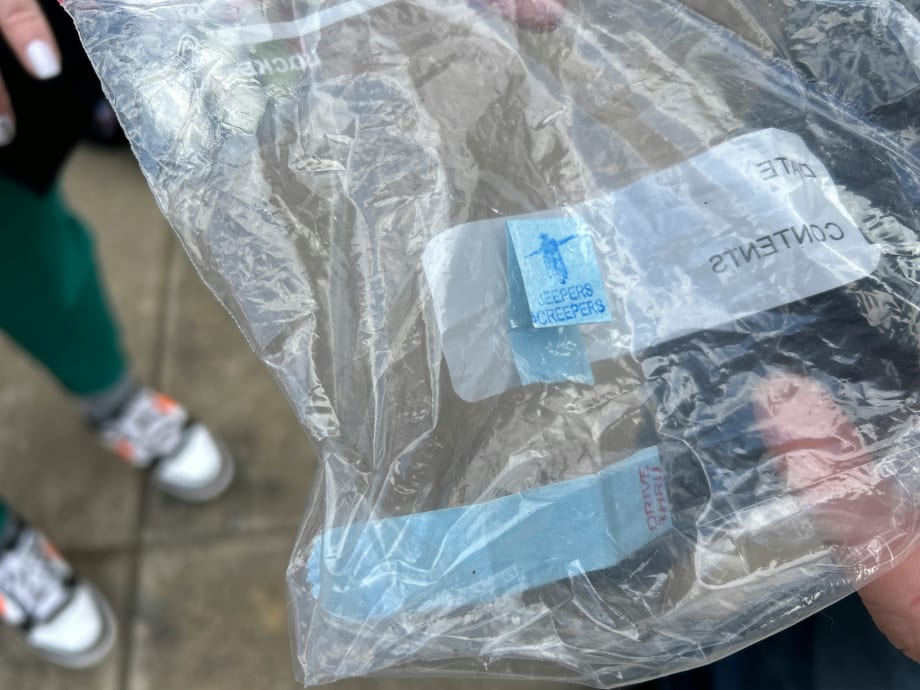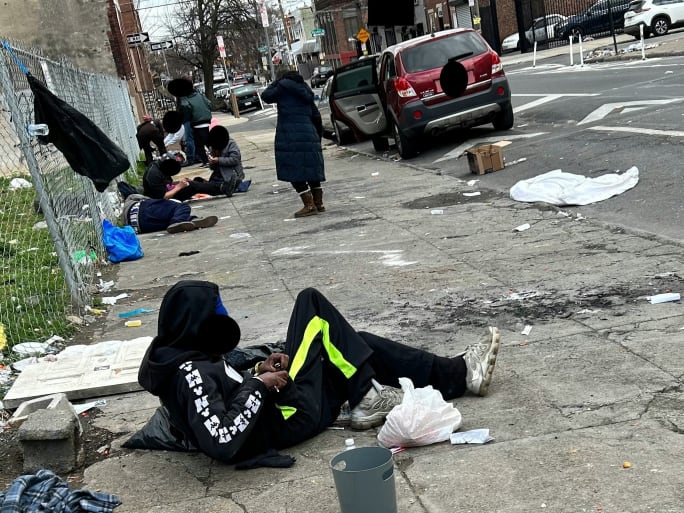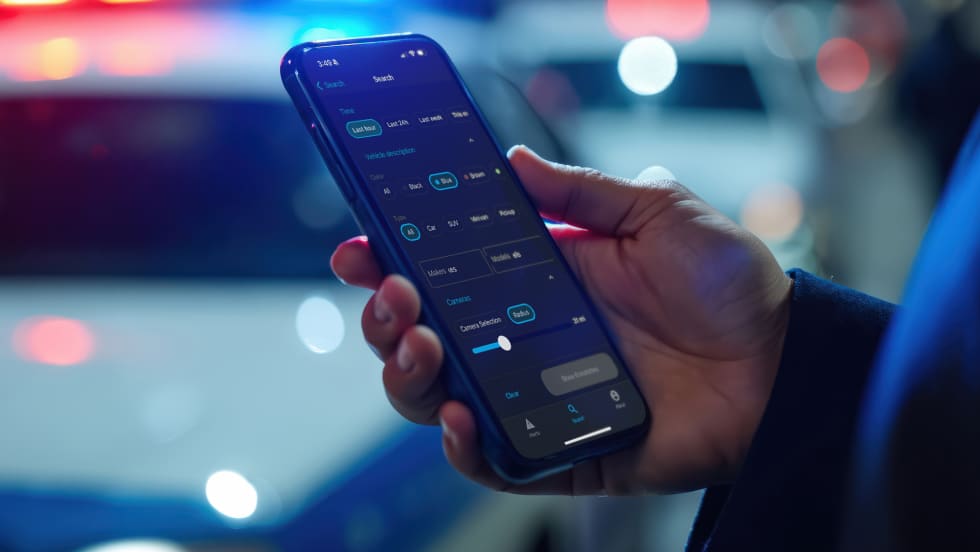The U.S. Drug Enforcement Administration (DEA) recently announced that it had seized more than 77 million fentanyl pills and nearly 12,000 pounds of fentanyl powder for the 2023 calendar year. This is equivalent to 386 million deadly doses of fentanyl—enough to kill every American—and to date is the largest amount of fentanyl that the agency has seized in a calendar year.
Mitigating the Threats of Fentanyl-Related Inner-City Violence
As distributors and dealers make money plying their trade—and potential profits are enormous—they look for new opportunities to expand drug distribution markets, which includes lacing heroin, amphetamines, and cocaine with traces of fentanyl.

Typical wax folders containing 2 to 3 grams of heroin and fentanyl in plastic bags as used by addicts.
Mike Brown
Comparatively, in 2022 the agency seized over 50.6 million fentanyl-laced fake prescription pills and more than 10,000 pounds of fentanyl powder. Analysis of these statistics illustrates the rapid growth in fentanyl use in cities and towns across our country.
The inner-city zones of large metropolitan areas are arguably the epicenters of fentanyl abuse. They have a large concentration of both users and potential customers who both drive demand and feed the fentanyl supply chain.
As distributors and dealers make money plying their trade—and potential profits are enormous—they look for new opportunities to expand drug distribution markets, which includes lacing heroin, amphetamines, and cocaine with traces of fentanyl.
Expansion means moving into one another’s territories and in the confinement of the inner cities, numerous trafficking gangs and criminal elements all bump into each other. The result is an explosion of violence because there are no unclaimed neighborhoods. The aftermath associated with the rapid release of violent energy ignites a chain reaction, unleashing gang upon gang retribution.
It’s a never-ending sequence of tragedy. The more fentanyl gets pushed out and distributed across America, the more people get hooked and die, the more money the cartels make. The violent cycle continues, media scrutiny increases, and pressure mounts for something to be done by law enforcement.
Gang Enforcement
One of the most important ways to mitigate gang violence associated with drug dealing is simply to vigorously enforce existing laws. The trend in recent years has been to treat high-level drug dealers, who often operate in communities of color in inner city areas, as victims of horrible childhoods or tragic backgrounds, homelessness, abuse, or neglect, and not as perpetrators of major crimes.
Meanwhile, some states have enacted drug decriminalization policies that allow the possession of 3 or fewer grams of most narcotics to be used, without any repercussions. Substance users are now camping out in our neighborhoods. The police aren’t arresting them. Prosecutors don’t want to prosecute anyone and there is a lack of appropriate drug treatment centers. There’s no accountability. As a result, violent crime increases and people wonder why.
What is needed now? Law enforcement agencies need to target fentanyl-impacted inner-cities and flood their “hot zones” with personnel that are mission-focused on ridding inner cities, and all areas, of violent trafficking gangs regardless of color. They need to aggressively degrade their fentanyl distribution capabilities using all legal methods at their disposal.

Open narcotic usage on the streets of Philadelphia.
Michael Brown
Proven Strategies
There are no new strategies to mitigate the fentanyl threat and there is no time to reinvent the wheel. Lives and cities are at stake. The successful urban counterdrug strategies that were implemented over the last 30 years must be reviewed and modified to meet current issues and threats on the streets in identified hot zones. Implementation of these strategies must occur without compromise for the cartels and their associates.
The DEA alone has taken down hundreds of major drug trafficking organizations over the years using proven sophisticated strategy-driven investigative methodologies.
The drug game today is still the same game that it was yesterday. The only difference now is the drug of choice—fentanyl. This killer isn’t taking any prisoners, and if law enforcement wants to prevail, it must act decisively.
South Asian countries generally have zero-tolerance policies and don’t see this problem. A zero-tolerance approach targeting high level dealers is vital across our country. Part of the new strategy must be to disincentivize 95% of those who would otherwise see trafficking as a new form of easy money to include internet drug trafficking. But, of course, this is very tough given the political pressure that many police departments and federal agencies are under. This level of scrutiny, which is sometimes beneficial to the accused, impacts counter-narcotic related strategies and ultimately doesn’t support many criminal investigations.
Intelligence is Critical
In order to successfully wage the campaign against drug trafficking, an increase in the specialized federal law enforcement High Intensity Drug Trafficking Areas (HIDTA) groups with enhanced training and greater intelligence development is urgently needed. These groups bring all the required incident partners to the table including the DEA, Department of Homeland Security, FBI, U.S. Customs and Border Protection, and state and local officers.
It comes back to flooding the zone, figuring out where the hot spots related to high rates of drug trafficking and other criminal activity are. Each zone must be flooded with these high-impact enforcement groups while working with community leaders. They should be everywhere and include an army of law enforcement analysts who have been trained to hack the hackers and penetrate deep into the web of drug trafficking.
In addition, human intelligence (HUMINT) is the most important aspect of any enforcement action. Law enforcement needs to understand how suspect groups are operating. The integration of human sources and electronic cyber communication warfare capabilities will be vital in the years ahead.
In our War on Drugs today, the insights that intelligence can deliver includes the identification of new drugs that are reaching cities; who the dealers are; the structure of their supply and distribution chains; how drug profits are being laundered; the identification of hot spot areas before they become critical trafficking zones; and what the overall new trafficking trends are. All enforcement information collected from operations must be analyzed and interpreted so that effective tactical decisions can be implemented to mitigate the current threats.
Part of the intelligence effort should also involve the establishment of secondary checkpoints a few miles from the U.S. and Mexican border crossings. At these checkpoints, law enforcement can either randomly conduct secondary checks of suspect vehicles after they have entered the country, or they can pull over vehicles for inspection based on specific intelligence identifying targets. Using highly training narcotics detection K-9s and specialized Raman spectroscopy devices, officers can examine suspected drug substances located in a vehicle without actually touching it, which is especially important when you are dealing with unknown substances which could be fentanyl.
Cyber Warfare
Even with the best intelligence, resources, manpower and training, the War on Drugs can’t be fully effective if it remains a strictly domestic effort. The reason is simple: The drugs originate across the southern border or overseas, locations where inner-city police departments cannot reach.
The problems are at the Mexican border crossings, which are controlled by the cartels. They represent the center of gravity, and they are protected by a shell government that functions as a narco-state. U.S. law enforcement authority stops at the border. Extraditions of Mexican drug lords have had little to no effect on degrading the capabilities of the cartels to acquire the essential precursor chemicals for the production of narcotics.
To be truly effective, the clandestine drug labs in Mexico must be taken out, and the precursor chemicals must be targeted at their source in the supply chain linked directly to China. This is where cyber warfare comes in.
Cyber warfare can be used to better target cross-border initiatives and to understand who the precursor chemical brokers are, and who the Chinese proxies are that assist in ordering, procuring, and shipping the precursor chemicals from China. The identification of shipping methods and transportation routes being used are critical to developing effective mitigation strategies.
Ultimately, cyber operations would identify the cartels’ vulnerabilities and who the proxies are in the U.S. that need to be deactivated. Once the precursor supply chain is broken, the cartels will be forced to reduce the current high production rates of fentanyl and the subsequent high rates of distribution into the Homeland. Until a decision is made to cross the Mexican border and put boots on the ground, aspects of cyber warfare represent the best next strategy to degrade the Mexican cartel fentanyl precursor supply distribution chain into America.
Beating the Odds
Due to the rising rates of fentanyl distribution and use, America’s inner cities are becoming more violent. The problem is hitting neighborhoods of color especially hard. A changing political and social climate is adding to the crisis, as drug dealers are sometimes portrayed as the victims and not perpetrators of crime.
Domestically, if America is going to get a handle on the crisis, it needs to get more serious about applying existing laws and take a zero-tolerance approach to enforcement related to high-level drug traffickers. Proven strategies successfully used in the past to combat the sale and distribution of narcotics should be updated and implemented by law enforcement officers tasked with tackling the sale and distribution of fentanyl and the violence that goes with it. All counter narcotic activities must be intelligence based so that suspect groups and their supply chains can be aggressively degraded. While the inner-city battle remains domestic, a concerted effort must be made to take the battle over our borders and globally using our country’s cyberwarfare capabilities.
Additionally, at our borders, better use of technology and electronic communications are needed to monitor, track and intercept the ever-increasing quantities of fentanyl pills and powder that are disseminating across the American landscape.
Law enforcement agencies require the appropriate tools and technology to better collaborate, target trafficking operations and permanently dismantle the criminal networks. Cooperation with willing foreign governments, to break the narcotic supply chains, disrupt drug production, and dismantle the threat that looms around us is also vital.
Decisive action is required now to ensure that inner city violent crime, as a result of the sale and distribution of fentanyl, does not spiral out of control.
Michael W. Brown is the global director for counter-narcotics technology at Rigaku Analytical Devices. He has a distinguished career spanning more than 32 years as a special agent for DEA. Most recently, he was the DEA Headquarters staff coordinator for the Office of Foreign Operations in the Middle East-Europe-Afghanistan-India. Prior to that, he served as the country attaché in India and Myanmar, providing foreign advisory support for counter narcotic enforcement. He also spent 10 years in Pakistan as a special advisor to the U.S. Embassy on various law enforcement issues. Brown is a graduate of the U.S. Army Ranger Training Battalion and has a master’s degree in inter-disciplinary technology and management from the University of Eastern Michigan. You can contact him at michael.brown@rigaku.com
More Technology

Motorola Solutions and Google Let Android Users Share Live Video with 911 in Seconds
Motorola Solutions’ 911 command center software now integrates with Google’s Android Emergency Live Video, so callers can let first responders see their emergency with a single click.
Read More →
From the Show Floor: Versaterm
Learn more about Versaterm as POLICE visits with Rohan Galloway-Dawkins, chief product officer, to explore the company’s focus on a purpose-built platform for public safety.
Read More →
From the Show Floor: Motorola Solutions
In this video, learn about the Motorola Solutions ecosystem and how it provides tools that enhance the efficiency and safety of police officers. You’ll hear about the APX NEXT radio and SVX system, Assisted Narrative, and more.
Read More →
Veritone & Armada Partner to Deliver Mission-Critical Edge Intelligence for Public Safety
Veritone and Armada will deliver a fully integrated edge-to-enterprise data fabric, capable of ingesting high-volume audio, video, drone, and sensor streams in the field and transforming them into actionable intelligence.
Read More →
Genetec Launches Cloudrunner Mobile App for Real-Time Vehicle Investigations in the Field
Genetec’s new Cloudrunner Mobile app extends Cloudrunner capabilities to the field, giving law enforcement and security professionals faster access to data and alerts wherever they are.
Read More →
Learning How to Manage Your Fleet?
Watch this tutorial on how fleet management platforms work. You’ll see how easily you can integrate fleet telematics, dash cameras, and asset management in a single pane of glass and manage your fleet more effectively.
Read More →
From the Show Floor: Semtech
Learn about the latest ruggedized routers designed for public safety vehicles as POLICE visits with Greg Hill of Semtech. These routers are equipped with the latest 5G technology.
Read More →
How One Police Department Cut Crime by 46% with Smarter Patrol Management
Discover how one police department cut crime nearly in half using smarter patrol data. This whitepaper breaks down the real-world strategy behind a 46% drop in vehicle thefts, improved officer safety, and stronger community visibility.
Read More →
Genetec Showcases Its Latest Public Safety Innovations at IACP 2025
Genetec demonstrated its Cloudrunner, Citigraf, and Clearance during IACP 2025 to show how they can provide law enforcement with a unified situational awareness to make cities safer.
Read More →
Ohio’s Statewide Drone First Responder Program to Take Flight
Over the next two years, the Ohio DFR Pilot Program will equip municipalities with advanced drone systems, deliver comprehensive training for first responders, and enable FAA-approved Beyond Visual Line of Sight operations.
Read More →
